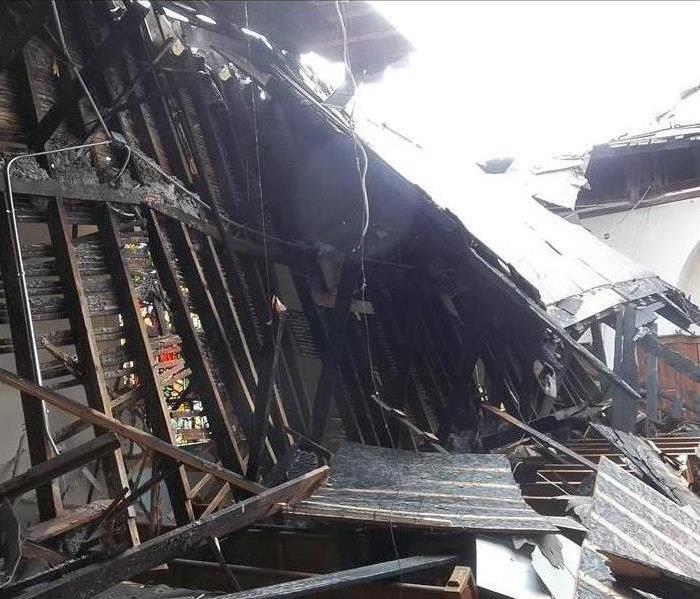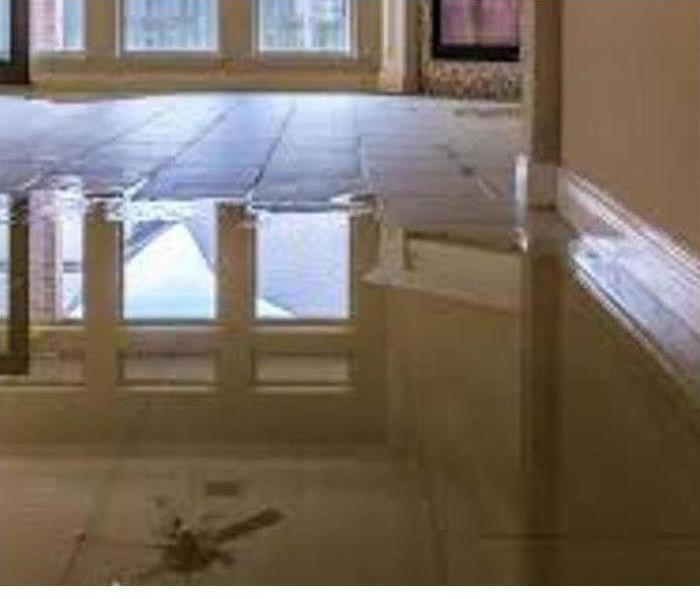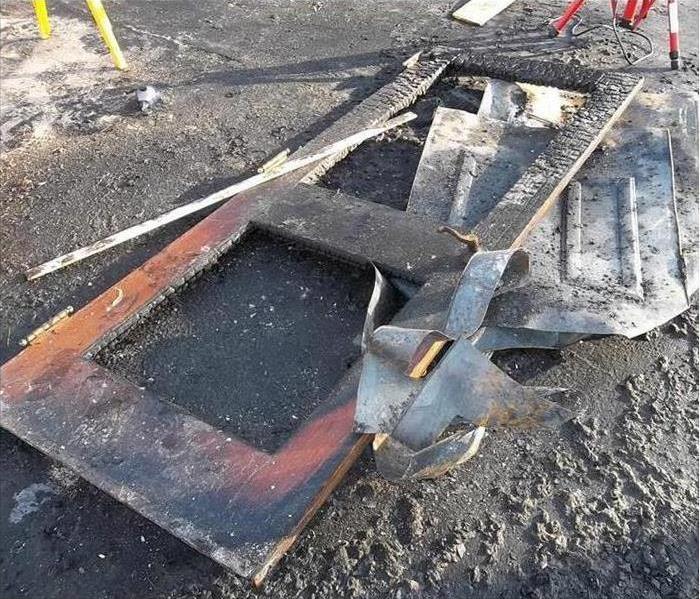Recent Posts
Water Damage Cleanup Mistakes
10/29/2024 (Permalink)
Experiencing water damage in your home or business can be extremely stressful, and most people react by trying to jump to action to clean up the mess immediately. While it’s crucial to begin mitigating the damage as soon as possible, certain mistakes could cause worse damage to your health, the structure, or both. The following are some of the most common mistakes property owners make in the face of unexpected water damage.
Doing it Yourself – The Wrong Way
How many times have you spilled something and said, “no big deal, it’s just water!” And this is completely true for small spills. The problem comes when this attitude attaches itself to larger water damage. Some water damage truly can be cleaned up with a DIY effort, but it’s important to know what you’re looking for so you don’t miss anything. Water is pervasive and can easily cause hidden damage if not properly dried. Drying out and restoring water damage is a far more time-consuming and intensive process than many people realize, which makes it easy to skip steps. Improper drying and cleanup can lead to more damage in the long run because it causes people to wait too long to complete the drying process.
Waiting Too Long
As mentioned, time is of the essence when dealing with water damage. For something that seems to be small water damage, it can be tempting to try to DIY and put off hiring a professional and calling your insurance company. A little bit of water doesn’t seem like that big of a problem. Unfortunately, even a small amount of water can cause a lot of damage. Water can seep into cracks and crevices where it will remain unseen, soaking into building materials and encouraging mold growth if it continues to go undetected and unmitigated. While the damage may seem small initially, it can quickly snowball into a massive problem.
Taking Short Cuts
The unfortunate fact of water damage restoration is the work done must be exceptionally thorough. There are no viable corners to be cut or shortcuts to take. The appropriate drying equipment must be used and properly monitored, and the amount of time it takes for the water to completely dry is just how long it takes. Properly drying, cleaning, and restoring water damage is an investment in both time and money if the job is done correctly. The consequences of taking shortcuts can be severe – from mold growth to degradation of building materials.
Not Hiring a Professional
Truly, the biggest mistake that can be made when handling water damage is not involving SERVPRO of Streamwood, Bartlett, West Chicago, & Warrenville. At the very least, a technician or project manager should come out and do readings with a moisture meter to assess the damage for you. Many property owners are surprised to realize the extent of the damage that can’t be seen with the naked eye. We have the equipment and knowledge to properly assess, dry, and restore water damage from any source, and it’s always best to involve an IICRC certified company such as SERVPRO of Streamwood, Bartlett, West Chicago, & Warrenville when you have water damage. The "small" water damage may be far more serious than you thought, and you may change your mind about filing an insurance claim.
What Causes Commercial Fires?
10/29/2024 (Permalink)
Business owners and employees must be on guard for these common causes of workplace fires, according to the NFPA:
- Cooking appliances and equipment. Cooking equipment remain as the leading cause of commercial fires, according to the NFPA. To prevent cooking fires, never leave appliances unattended, perform routine maintenance of kitchen and cooking equipment, and install sprinklers and smoke alarms.
- Electrical distribution and lighting equipment. Frayed or damaged wiring and malfunctioning lighting equipment should be repaired or replaced by a licensed technician immediately.
- Office or electronic equipment. Use electronic equipment correctly and never utilize defective or damaged electronic devices. Also, avoid overloading adapters and remove combustible materials near electronics.
- Heating equipment. Heating fire deaths are most often caused by placing the heating equipment close to flammable materials, such as bedding, mattresses or upholstery.
- Arson or intentional fires. This type of fire causes the most damage to commercial property and life. To prevent intentional fires, empty trash bins and dumpsters every day. Installing motion detector cameras can also help.
- Smoking materials. Create a smoking policy for your workplace, such as smoking outside and using ashtrays, to prevent the risk of fire.
- Exposure fires. If a fire is not contained, it could spread to other materials in its immediate surroundings and cause exposure fire. Protect objects from the heat spread to prevent them from igniting.
Be Wary Of Fire Danger When Grilling, Cooking Outdoors
10/29/2024 (Permalink)
Taking a few precautions when cooking or grilling outdoors can prevent unwanted fires. Here is a list of fire safety tips for grilling/cooking outdoors.
General
- During periods of high fire danger, consider alternatives to outdoor cooking.
- Check for burn bans prior to grilling/cooking outdoors.
- Propane and charcoal barbecue grills should only be used outdoors.
- Place the grill away from your home, deck, eves, and overhead branches.
- Never leave any fire unattended, including fires in barbecue pits.
- Remove any buildup of fats or grease from grills.
- Keep children and pets at least three feet away from the grill area.
- Have a water source nearby when cooking/grilling.
- Have a water hose connected to a faucet, uncoiled, and ready to turn on at a moment’s notice. Have a bucket of water near the grill. If no water is available, have a shovel ready to smother any escaped embers with sand/dirt.
Gas grills
- Check for leaks on gas grills prior to use.
- Make sure the gas grill lid is open before lighting it.
- Turn the grill and gas off if the flame goes out and wait at least five minutes before re-lighting.
- If you smell gas while cooking, immediately get away from the grill and call the fire department. Do not move the grill.
Charcoal grills
- Consider using a charcoal chimney starter that allows firing up charcoal without the use of starter fluid. There are also electric charcoal starters, which do not use fire.
- If using starter fluid, use only charcoal starter fluid. Never add charcoal fluid or any other flammable liquids to an ongoing fire.
- Keep charcoal fluid out of the reach of children and away from heat sources.
- Let coals cool completely and dispose of them in a metal container.
Fire Loss in Commercial Buildings
10/11/2024 (Permalink)
Fire, smoke, and soot can affect anything in your business or home, from the structure to personal belongings. After a fire, contacting a cleaning professional may be the best decision you can make.
Smoke and soot facts:
- Hot smoke migrates to cooler areas and upper levels of a structure.
- Smoke flows around plumbing systems, seeping through the holes used by pipes to go from floor to floor.
- The type of smoke may greatly affect the restoration process.
Different Types of Smoke:
There are two different types of smoke–wet and dry. As a result, there are different types of soot residue after a fire.
- Wet Smoke – Plastic and Rubber
- Low heat, smoldering, pungent odor, sticky, smeary. Smoke webs can be more difficult to clean.
Dry Smoke – Paper and Wood - Fast burning, high temperatures, heat rises therefore smoke rises.
- Protein Fire Residue – Produced by evaporation of material rather than from a fire
Virtually invisible, discolors paints and varnishes, extreme foul odor.
Since each smoke and fire damage situation is a little different, each one requires a unique solution. We have the equipment, expertise, and experience to restore your fire and smoke damage.
Call SERVPRO® of Streamwood/ Bartlett/ West Chicago City
630-562-9212
Water Damage: What To Look For
10/11/2024 (Permalink)
Often times the damage from water is caused when a problem goes without being noticed. It may take weeks or even months before the damage shows up.
Time is of the essence when you are dealing with any type of water damage, and the key is to act fast!
Not only can the water ruin your carpets, ceiling, and furniture, but it can also destroy precious family possessions, important documents, and irreplaceable, personal items.
You may need to vacate your home during the repairs, and the disruption of your normal routine could really have a huge impact on your way of life. Having to stay in a hotel or at a friend’s home isn’t the way you want to spend your week, or sometimes, weeks.
Moving quickly increases the chance that your belongings can be saved or restored.
Common Water Damage Causes
Water damage can take many different forms and show up in your home or business in a number of different ways. If you suspect that you might have water damage, it’s important to know what the common causes are so that you know how to prevent minor water damage from turning into a huge problem.
Some common causes are:
- A leaky roof from a passing rainstorm or melted snow from a snowstorm
- A broken pipe from your garbage disposal
- Condensation around your air conditioner
How Quickly Should I Address Water Damage?
Even if the issue is handled swiftly, water damage has been known to wreak havoc even months down the road. Often times the leak isn’t noticeable and may be behind a wall or in the ceiling.
The longer a leak goes unnoticed, the more money it can cost you to get fixed. Moving quickly also increases the chance that your personal belongings can be saved or restored.
Fire Prevention Tips
10/11/2024 (Permalink)
Here are some of the top home fire starters with tips on the best way to prevent them:
Cooking
Cooking is the main cause of home fires. Unattended cooking, and grease build-up, are the most frequent reasons for fires in the kitchen. Continuously supervise the range or stove when cooking and keep the kitchen surfaces free from grease to prevent fires.
Candles
Fires caused from candles are more frequent during holidays, such as Christmas and Halloween. Always keep candles far from draperies, embellishments and other combustibles, and ensure candle holders are steady. Utilizing battery-operated candles rather than real candles is a much safer option.
Children Playing with Fire
Some children play with fire just wondering, not understanding that it can be extremely dangerous. Keep lighters, matches and other flammables out of youngsters' sight and reach. Likewise, avoid as much as possible from using lighters and matches in front of them, as many children mimic what they see the adults do.
Heating Equipment
Amid the colder months, heating equipment, for example electric radiators or fireplaces, are major fire hazards in the home. Place radiators at a safe distance from combustible materials and always supervise them when they are operating. Check your smokestacks for creosote build-up on a regular basis and never utilize combustible fluids to begin a fire in the fireplace.
Electrical Causes
Obsolete wiring and breaker boxes, as well as old appliances, present a fire risk. Additionally, connecting excessively numerous machines to an extension cord can cause the cord or appliance to overheat and a fire to start. Watch for worn cords with exposed wires.
Smoking
Fires brought about by lit cigarettes can begin when a person nods off with a cigarette in hand or when the embers from a butt fall on ignitable materials. Smoke outside to avoid these dangers. On the off chance that you smoke inside, abstain from doing as such when tired, and use deep and large ashtrays.
Flammable Liquids
Liquids that can catch fire include gasoline, paints, cleaning agents, thinners, and much more. Keep these chemicals in approved compartments and far from electrical and heat sources. Store them outside, in a well-ventilated area. Always read the labels for temperature ranges.
Christmas Trees
Amid the Christmas season, many home fires can begin because of the careless utilization of Christmas tree adornments. Electrical failures and candles are the fundamental offenders of Christmas tree fires. Use only lights that have the mark of an independent testing laboratory. Furthermore, replace any string of lights with worn or broken cords or loose bulb connections. NEVER decorate your tree with lit candles. Water the tree on a daily basis to prevent the tree from drying out.
Where Your Smoke Alarms Should Go
10/9/2023 (Permalink)
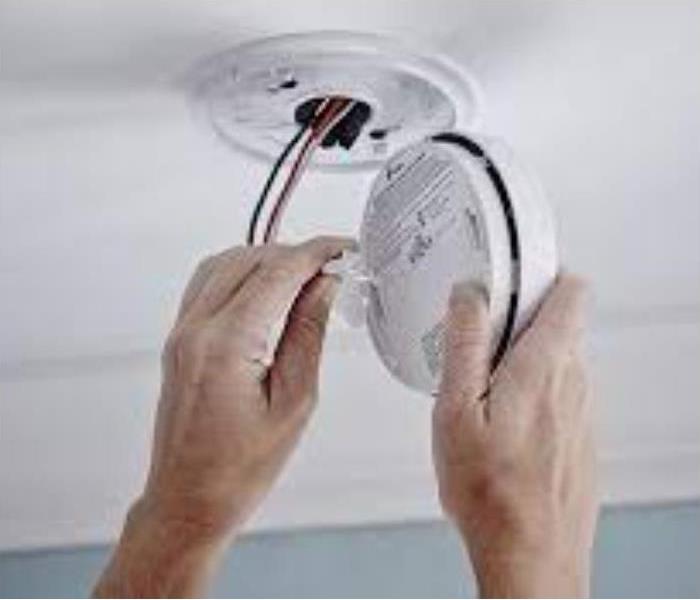 It is vital to know where to place your smoke alarms
It is vital to know where to place your smoke alarms
How Do You Know Which Smoke Detector To Get, and Where It Should Be Placed?
Smoke detection technologies include ionization smoke detection and photoelectric smoke detection.
- Ionization: this smoke detector is especially responsive to flaming fires
How it works: The Ionization smoke alarm has a little bit of radioactive material in-between two electrically-charged plates. These ionize the air while causing a current to flow in between the two plates.
Whenever smoke enters its chamber, it disrupts the flow of ions. This reduces the flow of current, activating the alarm.
- Photoelectric: this smoke detector is very responsive to a fire that begins after a long period of smoldering
How it works: Photoelectric smoke alarms work by aiming a light source into a sensing chamber. The chamber is at an angle, away from the sensor. The moment smoke enters its chamber, it reflects light onto the light sensor. This triggers the alarm.
Most fatal home fires are smoldering fires. The rest are flaming fires. It may be impossible to predict the type of fire you could have. All smoke alarm technology needs to perform acceptably for both types of fires.
Always place a smoke alarm on every floor, and in every sleeping room:
- Inspect every smoke detector once a month, and always change the batteries once a year. Your smoke detector will sense abnormal amounts of smoke - or invisible combustion gases escaping into the air.
- Every detector will detect both smoldering and burning fires. Always place at least one smoke detector on every level of your house. This way no matter what floor it is on - you can locate the nearest extinguisher more quickly.
If you ever have to suffer through the horrible event of a loss for any reason, it’s important to know that the caring professionals at , SERVPRO of Streamwood, Bartlett, West Chicago and Warrenville are there for you.
Risks of Owning a Business in a Floodplain Zone
10/9/2023 (Permalink)
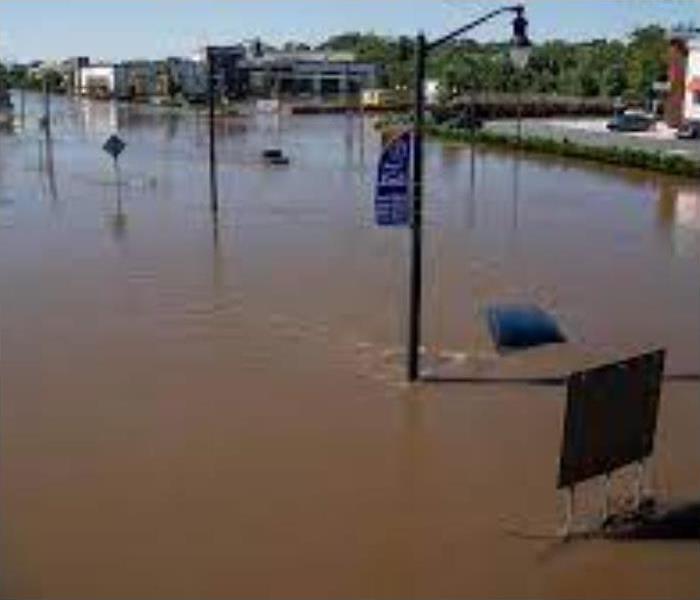 Depending on the location, a floodplain can be a minor component of a landscape or the primary feature.
Depending on the location, a floodplain can be a minor component of a landscape or the primary feature.
Floodplain zones help builders and business owners determine the level of risk associated with building in or inhabiting areas near a waterway (lake, river, stream, creek). Insurance agents use flood maps to identify the zones, which guide them in determining flood insurance requirements and coverage costs.
You can experience a devastating flood event, even if you live in a low-risk zone. Whether you live in a high- or low-risk floodplain zone, purchasing flood insurance is crucial to protect against financial losses resulting from floods, even if not required. Even a couple of inches of water can lead to several thousand or tens of thousands of dollars of damage.
If you choose to have your business in a floodplain zone, there are some important considerations to make:
- Purchase appropriate flood insurance (even if you aren’t required to by law).
- Use flood-resistant building materials in the home, such as laying tile instead of carpet, especially in the basement.
- Install flood vents, which allow the waters to flow through the vents and drain out.
- Elevate your property so the lowest floor is higher than the flood elevation level as identified on the flood map.
- Store belongings that would be adversely affected by water in a high location or a waterproof box to keep them safe from floodwaters.
- Have a plan in place for water damage restoration that you can utilize immediately following a flood event. Addressing water damage right away (within 24-48 hours) minimizes damage and avoids common post-flood problems like mold growth.
My Washing Machine Flooded the House
10/6/2023 (Permalink)
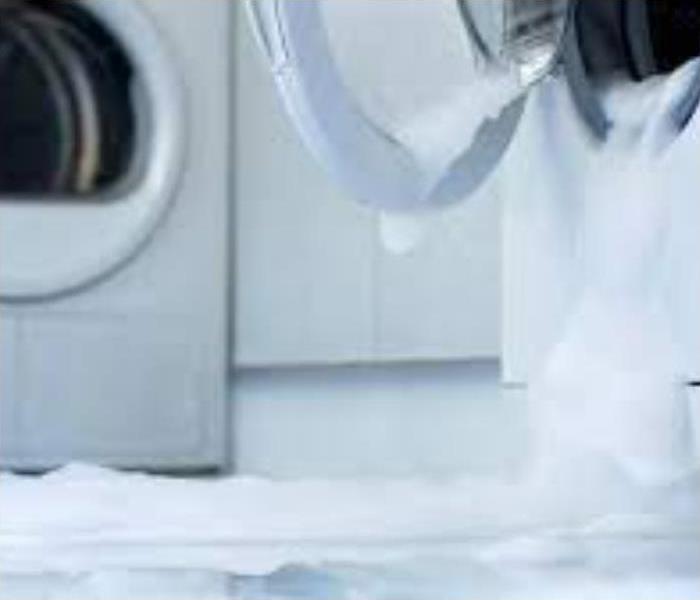 Flooding from a washing machine can leave your home with severe damage
Flooding from a washing machine can leave your home with severe damage
There are suds on the floor and water everywhere. The feeling of coming home to find the washing machine flooded the carpet is one of the worst. Not only are there dangers of electric shock and slipping on the sudsy floor, but after it’s all done, the water damage can continue to harm your home with mold and rot. Here’s what to do in the event of washing machine flooding, and how to avoid it next time.
What to Do When There’s a Washing Machine Flood
If your washing machine flooded, or is currently in the process, it’s important to act immediately to minimize the water damage:
Close the main water supply to keep the water from pouring.
Turn off the electrical breaker before unplugging the washer.
If the leak seems to be coming from the plumbing connections to the washer, call an experienced plumber. If it seems to come from the washer itself, call an appliance repair expert.
Call 24/7 water damage restoration expert, such as SERVPRO of Streamwood, Bartlett, West chicago and Warrenville. We can thoroughly dry out the room with our specialized equipment and processes, and we’ll inspect structures and surfaces to recommend ways to prevent hidden degradation and mold growth.
Protect your nearby belongings. Tie up curtains, put aluminum foil under furniture legs, and remove all books, clothes, shoes, and other items that could be stained.
Call your insurance company. Your policy likely requires you to report the damage and losses as soon as you possibly can.
The speed of your response is key in this situation. It only takes 24 hours for mold to develop in wet carpet or damp drywall. Soaked carpet may need replacing, and wooden floors warp and rot after extended water saturation. Even tile flooring can become loose and develop mold or rot in the subfloor.
Why Is My Washing Machine Flooding?
It’s essential that you find out so you can prevent another flood. Your washing machine may be flooding for these common reasons:
Too much detergent, especially if you have soft water
Overloaded washing machine (more than 2/3 full)
Faulty inlet or outlet hose
Faulty valve
Plumbing failure
Why Is My Washing Machine Leaking?
Perhaps your washer hasn’t flooded but you notice a little bit of water on the floor. Here are some common reasons your washer might be leaking:
Lint-clogged floor drain
Damaged or kinked external water supply hose
Internal hose or drain pump
Weak door seals (if a front-loading unit is leaking from the front)
Loose hose connections
Biohazard Cleanup for Hospitality, Commercial, Industrial, and Rental Property Owners
10/7/2022 (Permalink)
 A biohazard is any biological substance that poses a threat to the health of all living organisms
A biohazard is any biological substance that poses a threat to the health of all living organisms
Why SERVPRO for Biohazard Cleanup?
Commercial biohazard clean up is challenging work and should be left to the SERVPRO of Streamwood, Bartlett, West Chicago and Warrenville. However, if you have a biohazard situation at hand, you must get in touch with a biohazard cleaning company as soon as possible. The more you wait, the higher are the chances of you and your employees being exposed to biohazards.
When many businesses come face-to-face with biohazard situations, they try to stage a cover-up by employing amateur cleaning techniques. Unfortunately, this could prove to be a very costly mistake. Not only can employees get exposed to hazardous materials, but the business can also get a bad rap.
Cleanup work requires special training and expertise. Anyone who handles biohazards is at high risk of exposure to hazardous materials. Biohazard cleanup specialists are trained to handle and dispose of biohazards safely.
If someone committed suicide or was murdered at your facility, you are responsible for cleaning or decontaminating the scene. If the crime scene cleanup is not your forte and your employees are not mentally or emotionally equipped to handle crime scene cleanup, you should hire a biohazard cleanup specialist.
A biohazard cleanup specialist is qualified to handle such cleanup and eliminate all sensory reminders of the unfortunate event.
Biohazard Cleanup Process
? Once the expert arrives at your facility, they might seal the area to reduce contamination risks.
? They will put on safety gear and prepare disinfectant.
? Then, using tongs or forceps, the team will remove any sharp objects such as broken glass, metal shards, medical sharps, or razor blades.
? They will then cover the spill area with absorbent material.
? Next, the team will remove the absorbent material, place it in the biohazard bag, and apply an EPA registered disinfectant to the contaminated area.
? The disinfectant should be allowed to sit for a few hours. Using paper towels, the team will then remove disinfectant and place the paper towels in a biohazard bag.
? They will then place the biohazard bag in a biohazardous waste container for treatment and disposal.





 24/7 Emergency Service
24/7 Emergency Service
